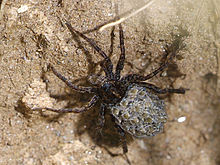
The spider species Tegenaria domestica, commonly known as the barn funnel weaver in North America and the domestic house spider in Europe, is a member of the funnel-web family Agelenidae.
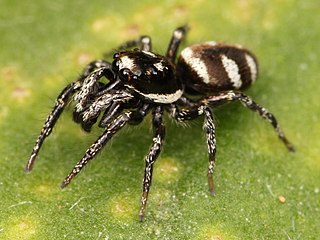
The zebra spider is a common jumping spider of the Northern Hemisphere. Their common name refers to their vivid black-and-white colouration, whilst their scientific name derives from Salticus from the Latin for “jump”, and the Greek scenicus, translating to “theatrical” or “of a decorative place,” in reference to the flashy, zebra-like coloration of the species.

The raft spider, scientific name Dolomedes fimbriatus, is a large semi-aquatic spider of the family Pisauridae found throughout north-western and central Europe. It is one of only two species of the genus Dolomedes found in Europe, the other being the slightly larger Dolomedesplantarius which is endangered in the UK.

The nursery web spider Pisaura mirabilis is a spider species of the family Pisauridae.

Micrommata virescens, common name green huntsman spider, is a species of huntsman spiders belonging to the family Sparassidae.
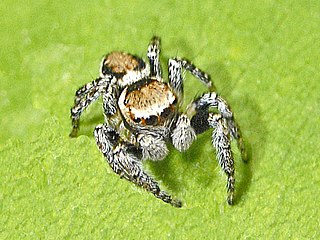
Evarcha falcata is a species of 'jumping spiders' belonging to the family Salticidae.

The book Svenska Spindlar or Aranei Svecici is one of the major works of the Swedish arachnologist and entomologist Carl Alexander Clerck and was first published in Stockholm in the year 1757. It was the first comprehensive book on the spiders of Sweden and one of the first regional monographs of a group of animals worldwide. The full title of the work is Svenska Spindlar uti sina hufvud-slägter indelte samt under några och sextio särskildte arter beskrefne och med illuminerade figurer uplyste – Aranei Svecici, descriptionibus et figuris æneis illustrati, ad genera subalterna redacti, speciebus ultra LX determinati, and included 162 pages of text and six colour plates. It was published in Swedish, with a Latin translation printed in a slightly smaller font below the Swedish text.

Agelena labyrinthica is a species of spider in the family Agelenidae. It is a widespread species in Europe and its range extends to Central and East Asia.

Pardosa amentata, otherwise known as the wolf spider or spotted wolf spider is a species of spider in the genus Pardosa belonging to the family of wolf spiders, Lycosidae. The species has a widespread distribution in central Europe and northwestern Europe and are commonly found on the British Isles. The species hunts its prey on the ground rather than weaving a web.
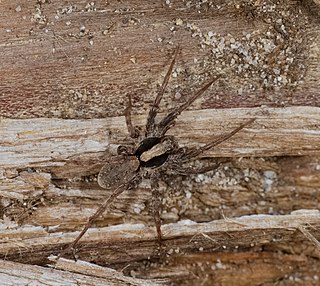
Xerolycosa nemoralis, or the burnt wolf spider, is a species of wolf spider found from western Europe eastwards to the Pacific.

Trochosa terricola is known as the ground wolf spider, is a wolf spider which is common and widespread in western and central Europe. It has been recorded as prey for the pompilid wasp.

Xysticus cristatus, the common crab spider, is a European spider from the family Thomisidae.

Phylloneta sisyphia, the mothercare spider, is a species of comb-footed spider from the genus Phylloneta.

Philodromus aureolus, the wandering crab spider, is a mainly European running crab spider of the family Philodromidae. The taxonomy of the species group named after Philodromus aureolus is in a state of flux and a number of new species have recently been recognised.

Icius minimus is a species of jumping spider in the genus Icius that lives in Ethiopia. It was first described in 2008 by Wanda Wesołowska and Beata Tomasiewicz. The spider is small, with a cephalothorax between 1.5 and 2.3 mm long and an abdomen 1.8 and 3.3 mm long. The male is smaller than the female, as is recalled in the species name. The spider is similar to the related Icius pulchellus but has a distinctive pattern on the abdomen. The male abdomen is brown with two white stripes fringed with black lines. The female has a large white patch and a pattern of wide stripes, mostly interrupted. The male tibial apophysis is also unusual, being short and shaped like a spatula. The female has longer receptacles than other spiders in the genus.
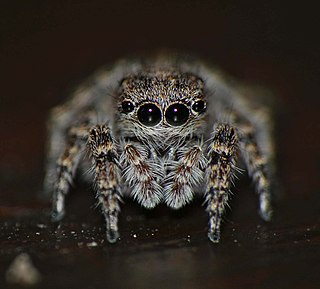
Langelurillus furcatus is a species of jumping spider in the genus Langelurillus that lives in Kenya and Tanzania. It was first described in 2000 by Wanda Wesołowska and Anthony Russell-Smith. The spider is small, with a carapace that is between 1.8 and 2.4 mm long and an abdomen between 1.7 and 2.7 mm long. The male is smaller than the female. It has a dark brown carapace, although the female is lighter, that has no markings. The female abdomen is dark russet with a pattern of black and white patches and the male abdomen is dark fawn with an indistinct light pattern. It has orange legs with dark patches, the female also having dark rings on its legs. The spider is similar to other related species, particularly Langelurillus alboguttatus, but can be distinguished by its two tibial apophysis, which make a V-shape. The epigyne has a deep depression that is plugged with a waxy secretion.

Aelurillus basseleti is a species of jumping spider in the genus Aelurillus that has been found in Algeria, Morocco and Tunisia. Originally named Salticus basseleti, the spider was first identified in 1846 by Hippolyte Lucas, but the original male holotype has been lost. The female was first described in 2006. The spider is small and hard to distinguish from the related species Aelurillus luctuosus and Aelurillus monardi. The dark brown carapace is typically between 2.8 and 3.4 mm long and the grey-yellow abdomen is between 2.3 and 4 mm long, the female being larger than the male. The carapace has a single stripe down the middle. While the female is hard to distinguish compared to others in the genus, the male spider has distinctive white or tawny bands on the clypeus. The male has a curved embolus that is sufficiently varied between individual spiders that it is not sufficiently specific to identify the species.
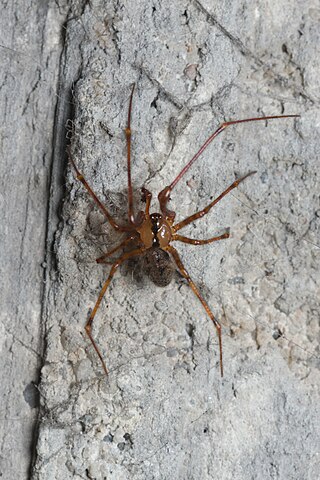
Nesticus cellulanus, also known as the cavity spider or comb-footed cellar spider, is a species of scaffold web spider. It is found throughout Europe and Turkey, and has been introduced to North America.
Diphya wesolowskae is a species of long-jawed orb weaver in the genus Diphya that lives in South Africa. First described in 2020 by Mikhail Omelko, Yuri Marusik and Robin Lyle, the spider is small, with a typical length between 2.8 and 3.17 mm. The female is larger than the male. It has a brown to dark brown and patternless carapace, which distinguishes the species from the more common Diphya simoni. The male has an abdomen that is also brown to dark brown and has a pattern of two dark spots, although some examples have more complex, but indistinct, patterns of spots and stripes. The female has a light brown abdomen marked with large spots and stripes. The copulatory organs are distinctive to the species. The female has a epigyne that lacks pockets but has a thicker septal stem than Diphya foordi, and the male has a very long, thin projection that extends from the palpal bulb beyond the cymbium and a very short embolus.

Pardosa astrigera is a species of wolf spider in the family Lycosidae. They are found throughout Japan, Korea, China, Taiwan, and far east Russia.

